Theories of Governance and Stewardship: Applications in Organizations
VerifiedAdded on 2023/04/03
|17
|2901
|312
Essay
AI Summary
This essay explores governance and stewardship theories, examining their impact on organizational management in both non-profit and for-profit settings. It delves into key theories such as Agency Theory, Resource Dependency Theory, Stakeholder Theory, and Transaction Cost Theory, highlighting their relevance in shaping organizational effectiveness. The paper also discusses Stewardship Theory, contrasting its application in non-profit and for-profit organizations, emphasizing the role of leaders as stewards who prioritize the interests of stakeholders. Furthermore, it analyzes the relationship between a leader's values and beliefs and their influence on organizational performance, ultimately concluding that effective leadership, grounded in strong ethical principles, is crucial for fostering a culture of responsibility, transparency, and long-term success.
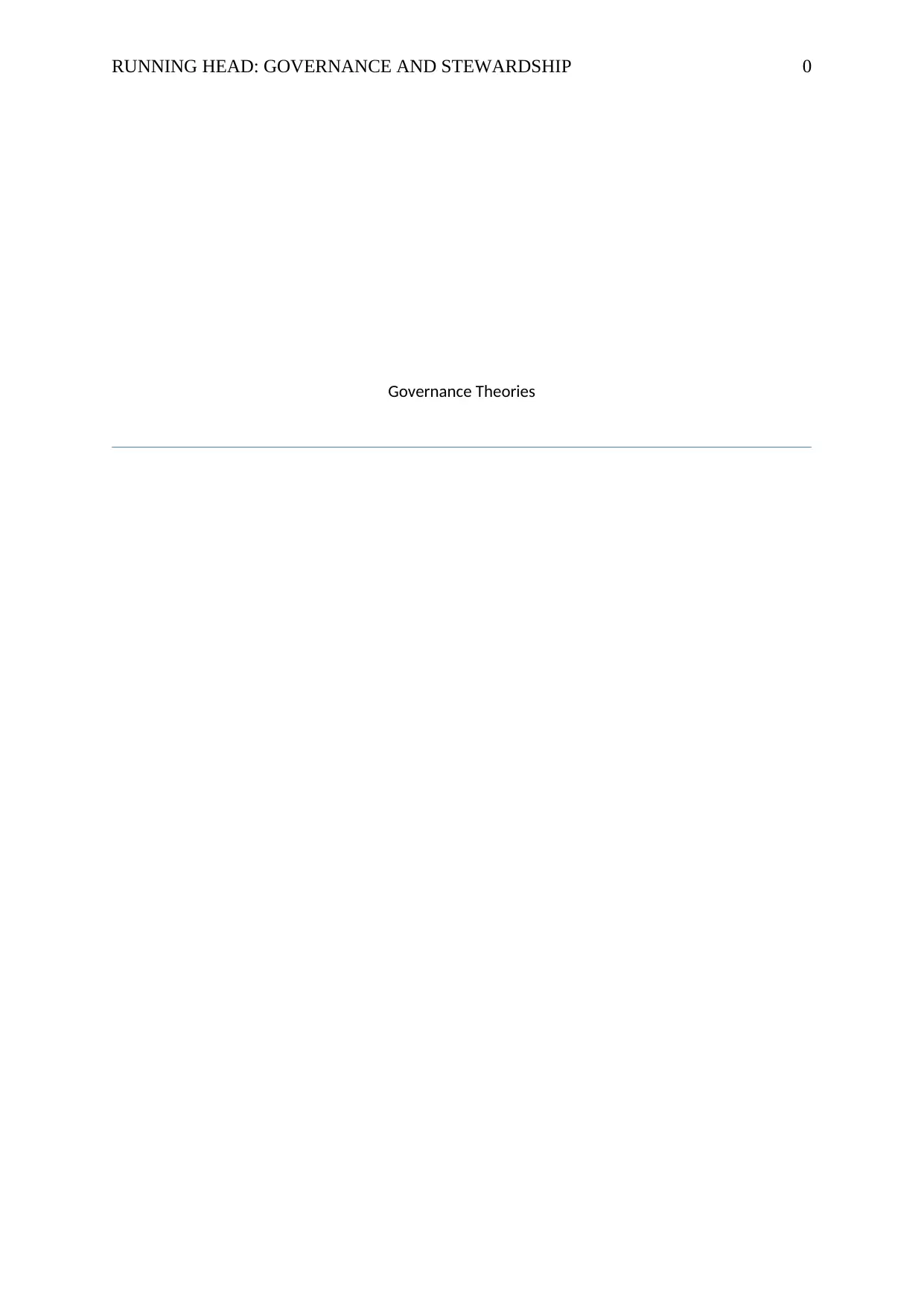
RUNNING HEAD: GOVERNANCE AND STEWARDSHIP 0
Governance Theories
Governance Theories
Paraphrase This Document
Need a fresh take? Get an instant paraphrase of this document with our AI Paraphraser
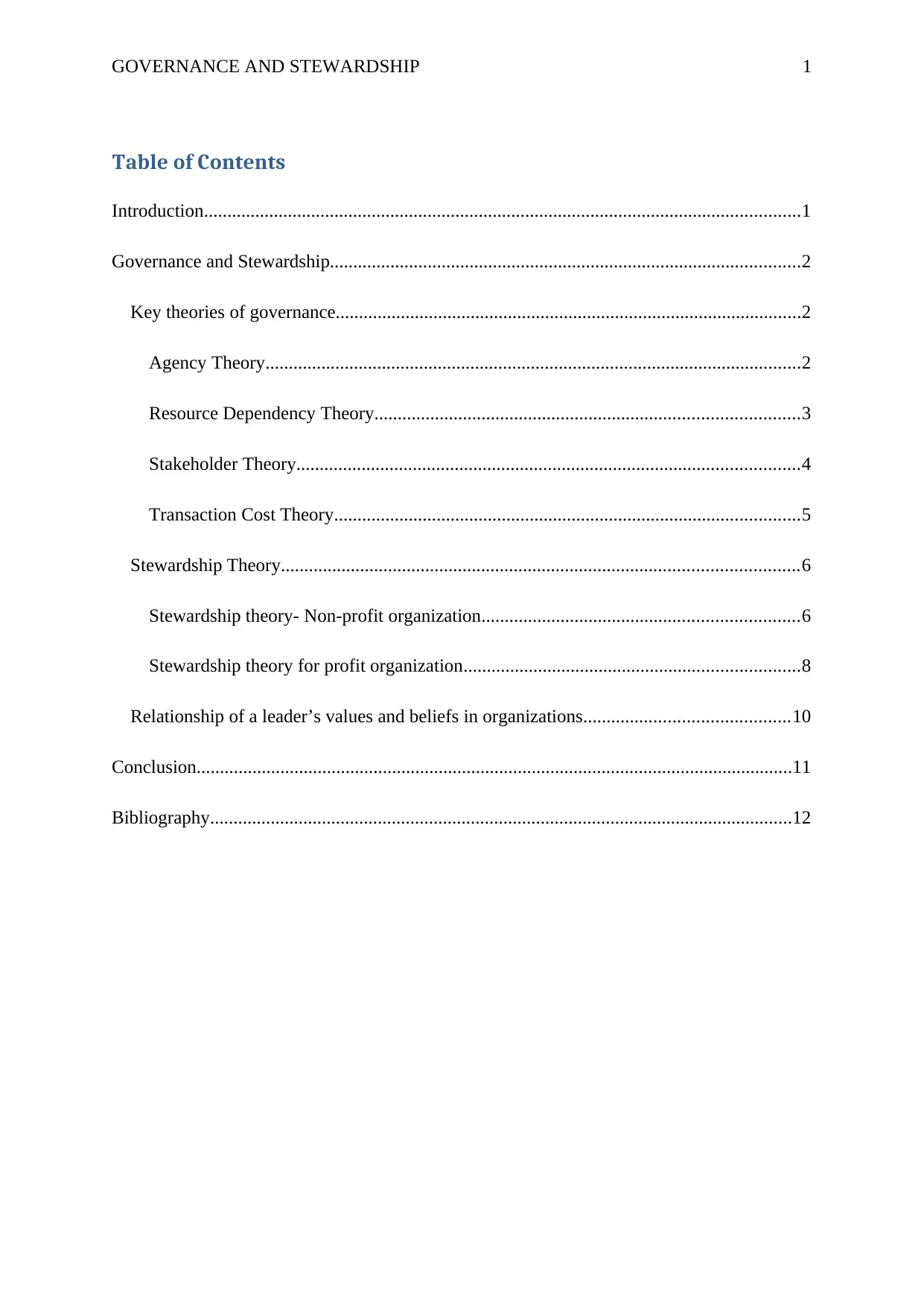
GOVERNANCE AND STEWARDSHIP 1
Table of Contents
Introduction................................................................................................................................1
Governance and Stewardship.....................................................................................................2
Key theories of governance....................................................................................................2
Agency Theory...................................................................................................................2
Resource Dependency Theory...........................................................................................3
Stakeholder Theory............................................................................................................4
Transaction Cost Theory....................................................................................................5
Stewardship Theory...............................................................................................................6
Stewardship theory- Non-profit organization....................................................................6
Stewardship theory for profit organization........................................................................8
Relationship of a leader’s values and beliefs in organizations............................................10
Conclusion................................................................................................................................11
Bibliography.............................................................................................................................12
Table of Contents
Introduction................................................................................................................................1
Governance and Stewardship.....................................................................................................2
Key theories of governance....................................................................................................2
Agency Theory...................................................................................................................2
Resource Dependency Theory...........................................................................................3
Stakeholder Theory............................................................................................................4
Transaction Cost Theory....................................................................................................5
Stewardship Theory...............................................................................................................6
Stewardship theory- Non-profit organization....................................................................6
Stewardship theory for profit organization........................................................................8
Relationship of a leader’s values and beliefs in organizations............................................10
Conclusion................................................................................................................................11
Bibliography.............................................................................................................................12
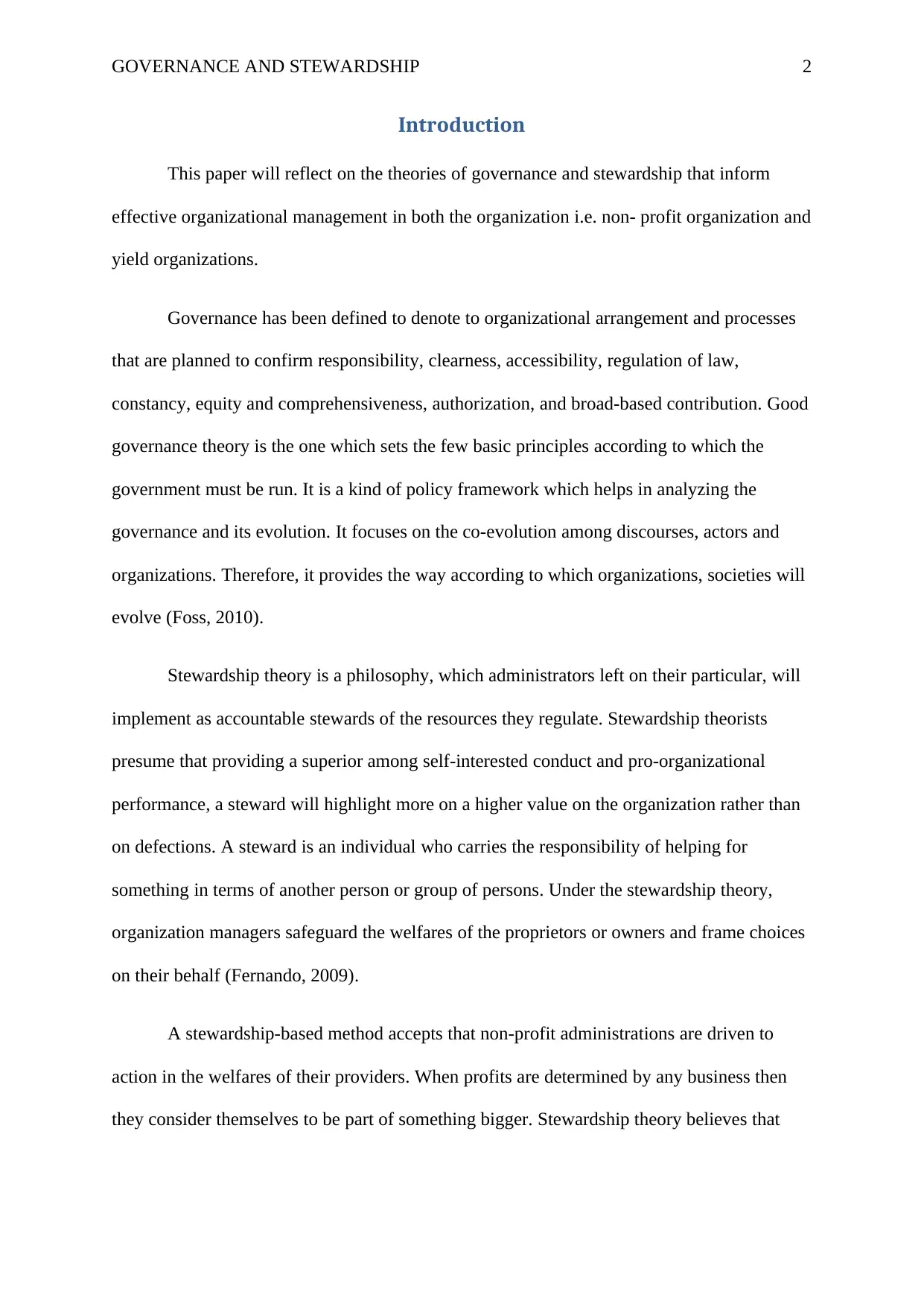
GOVERNANCE AND STEWARDSHIP 2
Introduction
This paper will reflect on the theories of governance and stewardship that inform
effective organizational management in both the organization i.e. non- profit organization and
yield organizations.
Governance has been defined to denote to organizational arrangement and processes
that are planned to confirm responsibility, clearness, accessibility, regulation of law,
constancy, equity and comprehensiveness, authorization, and broad-based contribution. Good
governance theory is the one which sets the few basic principles according to which the
government must be run. It is a kind of policy framework which helps in analyzing the
governance and its evolution. It focuses on the co-evolution among discourses, actors and
organizations. Therefore, it provides the way according to which organizations, societies will
evolve (Foss, 2010).
Stewardship theory is a philosophy, which administrators left on their particular, will
implement as accountable stewards of the resources they regulate. Stewardship theorists
presume that providing a superior among self-interested conduct and pro-organizational
performance, a steward will highlight more on a higher value on the organization rather than
on defections. A steward is an individual who carries the responsibility of helping for
something in terms of another person or group of persons. Under the stewardship theory,
organization managers safeguard the welfares of the proprietors or owners and frame choices
on their behalf (Fernando, 2009).
A stewardship-based method accepts that non-profit administrations are driven to
action in the welfares of their providers. When profits are determined by any business then
they consider themselves to be part of something bigger. Stewardship theory believes that
Introduction
This paper will reflect on the theories of governance and stewardship that inform
effective organizational management in both the organization i.e. non- profit organization and
yield organizations.
Governance has been defined to denote to organizational arrangement and processes
that are planned to confirm responsibility, clearness, accessibility, regulation of law,
constancy, equity and comprehensiveness, authorization, and broad-based contribution. Good
governance theory is the one which sets the few basic principles according to which the
government must be run. It is a kind of policy framework which helps in analyzing the
governance and its evolution. It focuses on the co-evolution among discourses, actors and
organizations. Therefore, it provides the way according to which organizations, societies will
evolve (Foss, 2010).
Stewardship theory is a philosophy, which administrators left on their particular, will
implement as accountable stewards of the resources they regulate. Stewardship theorists
presume that providing a superior among self-interested conduct and pro-organizational
performance, a steward will highlight more on a higher value on the organization rather than
on defections. A steward is an individual who carries the responsibility of helping for
something in terms of another person or group of persons. Under the stewardship theory,
organization managers safeguard the welfares of the proprietors or owners and frame choices
on their behalf (Fernando, 2009).
A stewardship-based method accepts that non-profit administrations are driven to
action in the welfares of their providers. When profits are determined by any business then
they consider themselves to be part of something bigger. Stewardship theory believes that
⊘ This is a preview!⊘
Do you want full access?
Subscribe today to unlock all pages.

Trusted by 1+ million students worldwide
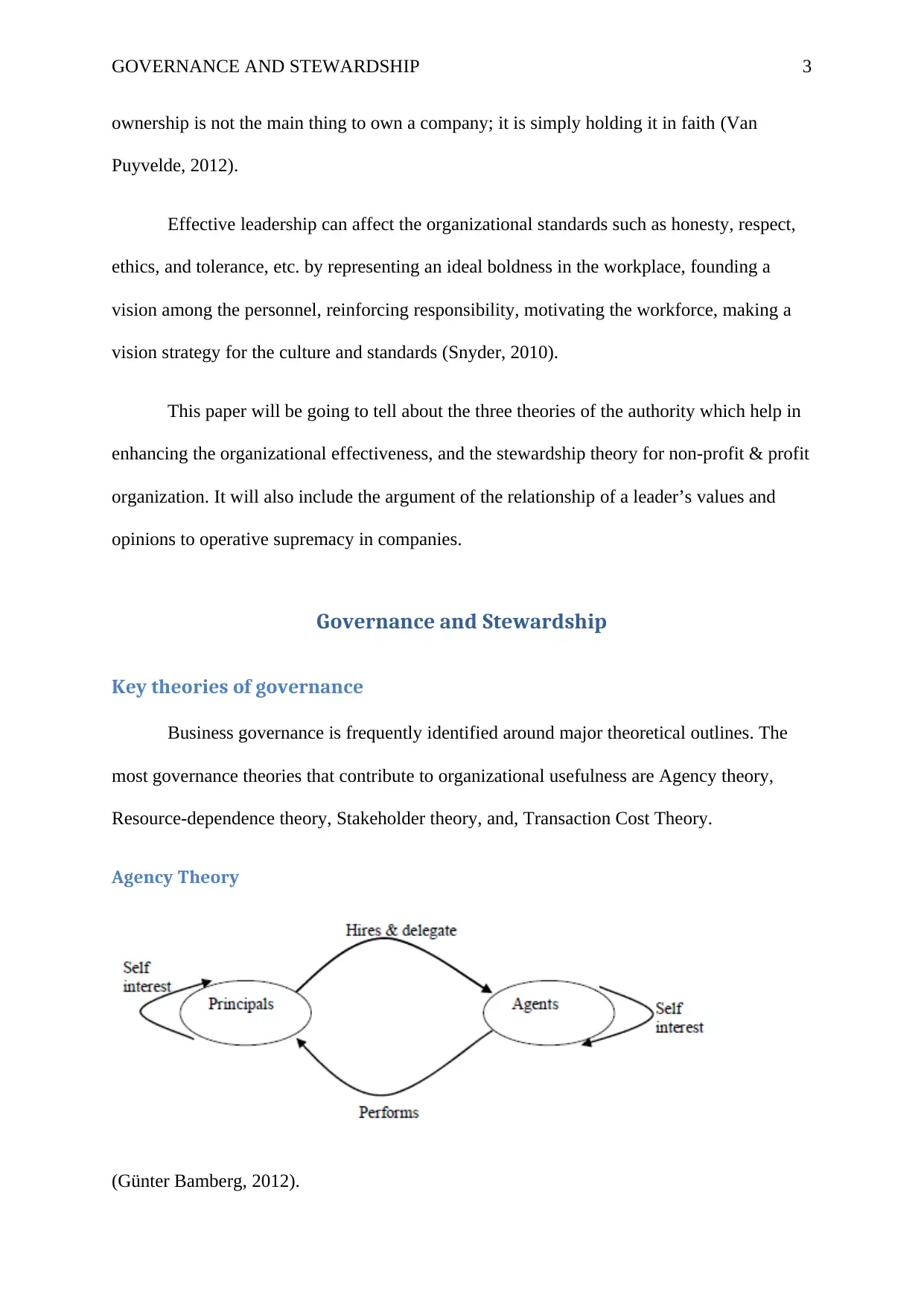
GOVERNANCE AND STEWARDSHIP 3
ownership is not the main thing to own a company; it is simply holding it in faith (Van
Puyvelde, 2012).
Effective leadership can affect the organizational standards such as honesty, respect,
ethics, and tolerance, etc. by representing an ideal boldness in the workplace, founding a
vision among the personnel, reinforcing responsibility, motivating the workforce, making a
vision strategy for the culture and standards (Snyder, 2010).
This paper will be going to tell about the three theories of the authority which help in
enhancing the organizational effectiveness, and the stewardship theory for non-profit & profit
organization. It will also include the argument of the relationship of a leader’s values and
opinions to operative supremacy in companies.
Governance and Stewardship
Key theories of governance
Business governance is frequently identified around major theoretical outlines. The
most governance theories that contribute to organizational usefulness are Agency theory,
Resource-dependence theory, Stakeholder theory, and, Transaction Cost Theory.
Agency Theory
(Günter Bamberg, 2012).
ownership is not the main thing to own a company; it is simply holding it in faith (Van
Puyvelde, 2012).
Effective leadership can affect the organizational standards such as honesty, respect,
ethics, and tolerance, etc. by representing an ideal boldness in the workplace, founding a
vision among the personnel, reinforcing responsibility, motivating the workforce, making a
vision strategy for the culture and standards (Snyder, 2010).
This paper will be going to tell about the three theories of the authority which help in
enhancing the organizational effectiveness, and the stewardship theory for non-profit & profit
organization. It will also include the argument of the relationship of a leader’s values and
opinions to operative supremacy in companies.
Governance and Stewardship
Key theories of governance
Business governance is frequently identified around major theoretical outlines. The
most governance theories that contribute to organizational usefulness are Agency theory,
Resource-dependence theory, Stakeholder theory, and, Transaction Cost Theory.
Agency Theory
(Günter Bamberg, 2012).
Paraphrase This Document
Need a fresh take? Get an instant paraphrase of this document with our AI Paraphraser
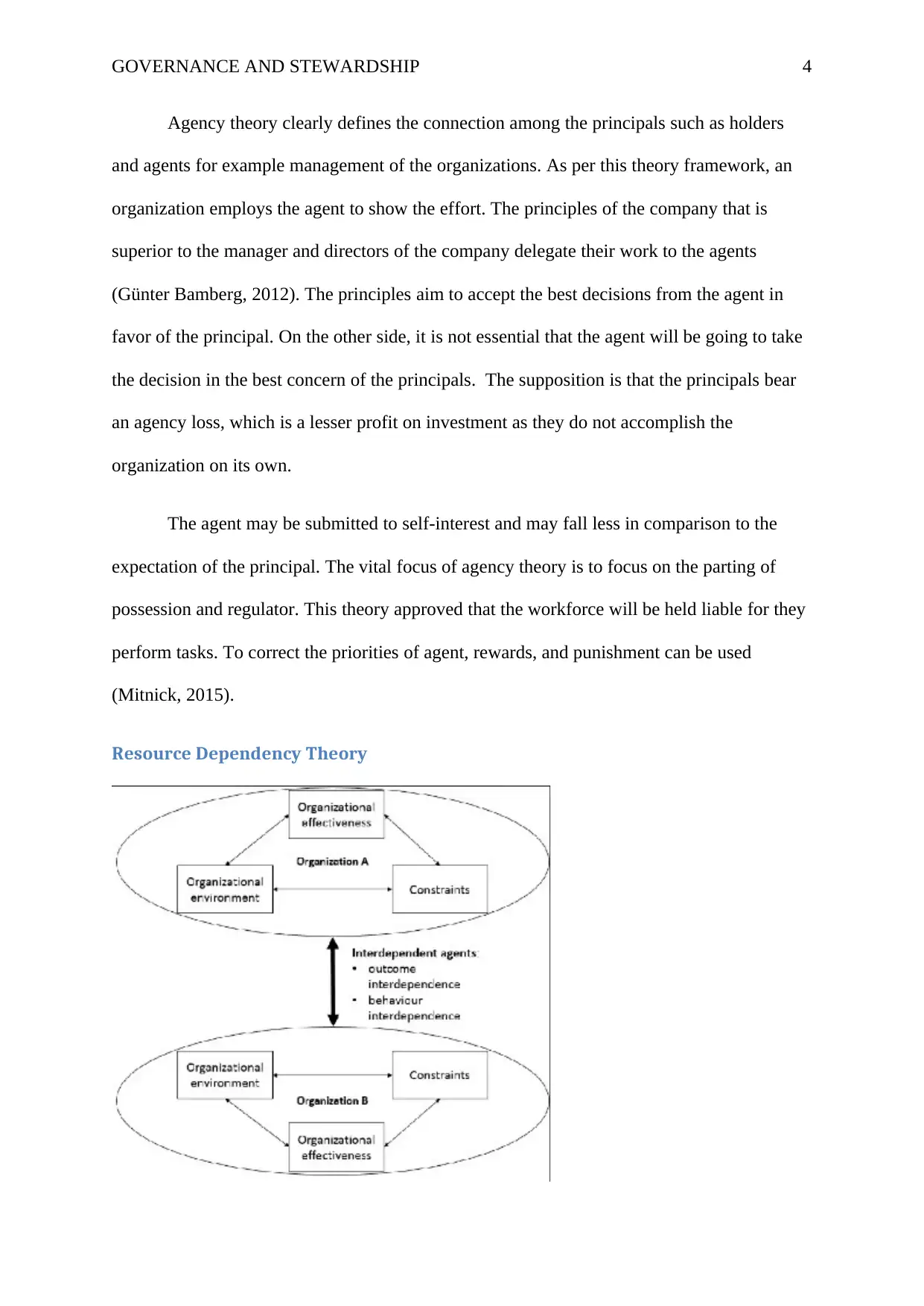
GOVERNANCE AND STEWARDSHIP 4
Agency theory clearly defines the connection among the principals such as holders
and agents for example management of the organizations. As per this theory framework, an
organization employs the agent to show the effort. The principles of the company that is
superior to the manager and directors of the company delegate their work to the agents
(Günter Bamberg, 2012). The principles aim to accept the best decisions from the agent in
favor of the principal. On the other side, it is not essential that the agent will be going to take
the decision in the best concern of the principals. The supposition is that the principals bear
an agency loss, which is a lesser profit on investment as they do not accomplish the
organization on its own.
The agent may be submitted to self-interest and may fall less in comparison to the
expectation of the principal. The vital focus of agency theory is to focus on the parting of
possession and regulator. This theory approved that the workforce will be held liable for they
perform tasks. To correct the priorities of agent, rewards, and punishment can be used
(Mitnick, 2015).
Resource Dependency Theory
Agency theory clearly defines the connection among the principals such as holders
and agents for example management of the organizations. As per this theory framework, an
organization employs the agent to show the effort. The principles of the company that is
superior to the manager and directors of the company delegate their work to the agents
(Günter Bamberg, 2012). The principles aim to accept the best decisions from the agent in
favor of the principal. On the other side, it is not essential that the agent will be going to take
the decision in the best concern of the principals. The supposition is that the principals bear
an agency loss, which is a lesser profit on investment as they do not accomplish the
organization on its own.
The agent may be submitted to self-interest and may fall less in comparison to the
expectation of the principal. The vital focus of agency theory is to focus on the parting of
possession and regulator. This theory approved that the workforce will be held liable for they
perform tasks. To correct the priorities of agent, rewards, and punishment can be used
(Mitnick, 2015).
Resource Dependency Theory
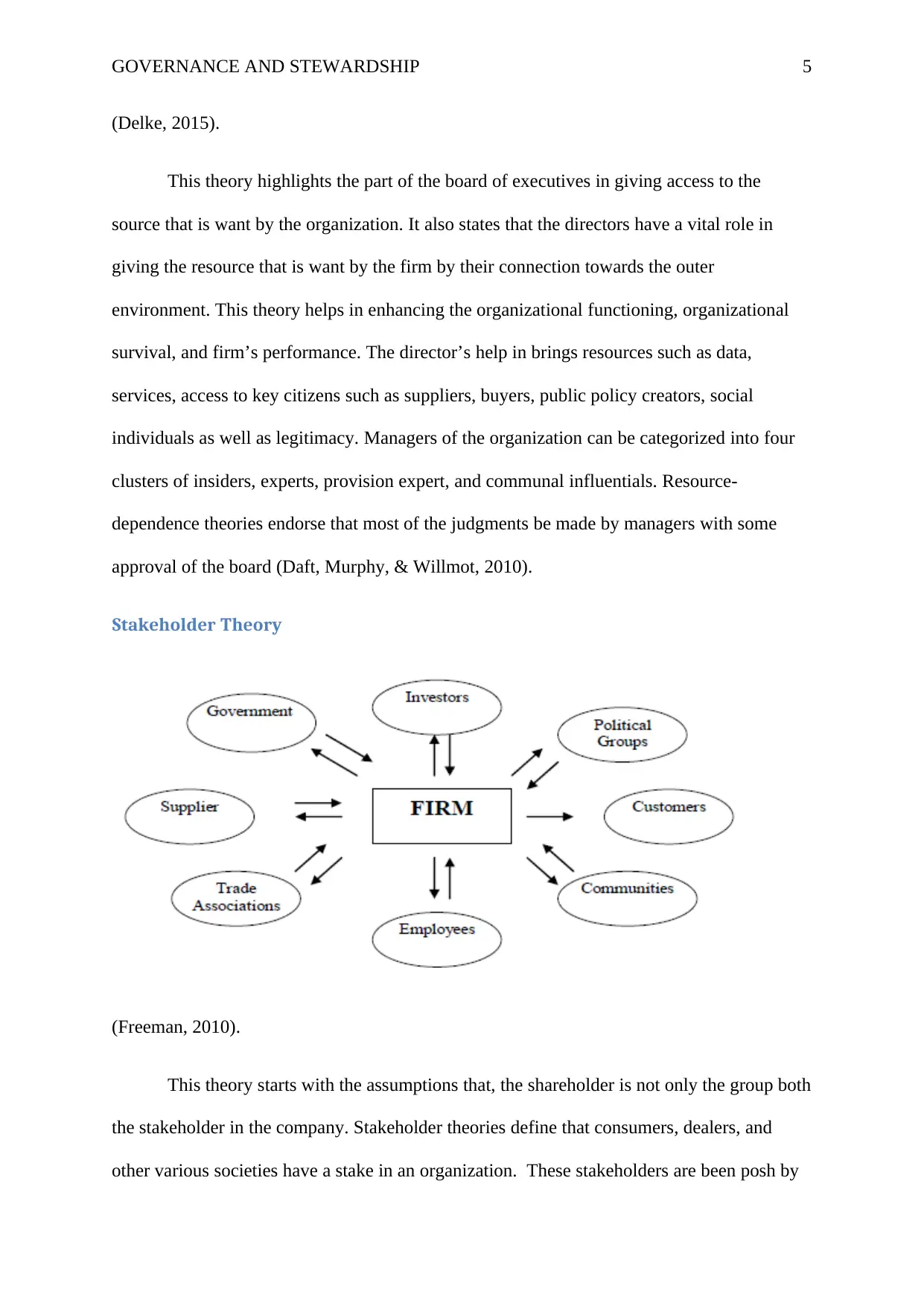
GOVERNANCE AND STEWARDSHIP 5
(Delke, 2015).
This theory highlights the part of the board of executives in giving access to the
source that is want by the organization. It also states that the directors have a vital role in
giving the resource that is want by the firm by their connection towards the outer
environment. This theory helps in enhancing the organizational functioning, organizational
survival, and firm’s performance. The director’s help in brings resources such as data,
services, access to key citizens such as suppliers, buyers, public policy creators, social
individuals as well as legitimacy. Managers of the organization can be categorized into four
clusters of insiders, experts, provision expert, and communal influentials. Resource-
dependence theories endorse that most of the judgments be made by managers with some
approval of the board (Daft, Murphy, & Willmot, 2010).
Stakeholder Theory
(Freeman, 2010).
This theory starts with the assumptions that, the shareholder is not only the group both
the stakeholder in the company. Stakeholder theories define that consumers, dealers, and
other various societies have a stake in an organization. These stakeholders are been posh by
(Delke, 2015).
This theory highlights the part of the board of executives in giving access to the
source that is want by the organization. It also states that the directors have a vital role in
giving the resource that is want by the firm by their connection towards the outer
environment. This theory helps in enhancing the organizational functioning, organizational
survival, and firm’s performance. The director’s help in brings resources such as data,
services, access to key citizens such as suppliers, buyers, public policy creators, social
individuals as well as legitimacy. Managers of the organization can be categorized into four
clusters of insiders, experts, provision expert, and communal influentials. Resource-
dependence theories endorse that most of the judgments be made by managers with some
approval of the board (Daft, Murphy, & Willmot, 2010).
Stakeholder Theory
(Freeman, 2010).
This theory starts with the assumptions that, the shareholder is not only the group both
the stakeholder in the company. Stakeholder theories define that consumers, dealers, and
other various societies have a stake in an organization. These stakeholders are been posh by
⊘ This is a preview!⊘
Do you want full access?
Subscribe today to unlock all pages.

Trusted by 1+ million students worldwide
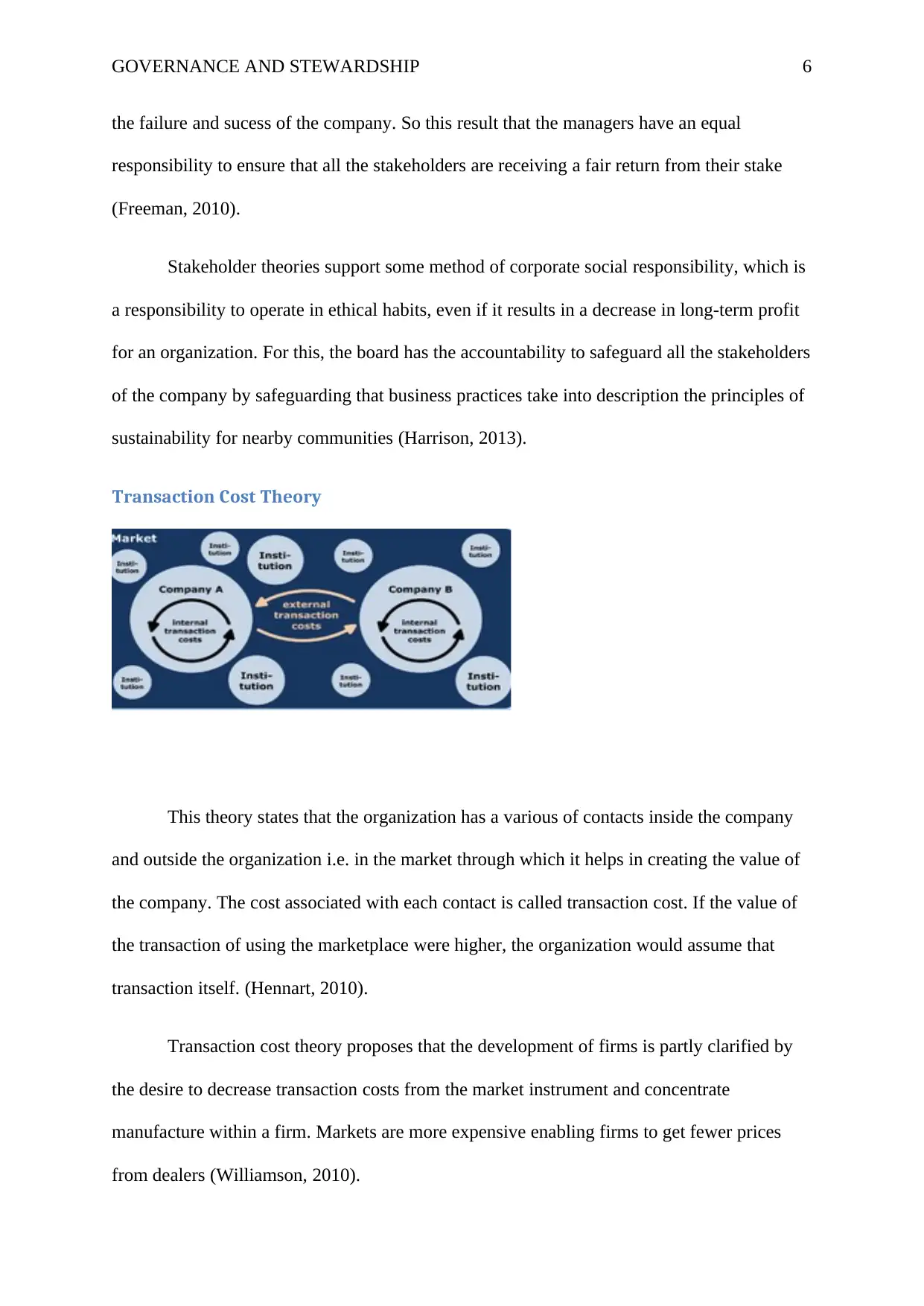
GOVERNANCE AND STEWARDSHIP 6
the failure and sucess of the company. So this result that the managers have an equal
responsibility to ensure that all the stakeholders are receiving a fair return from their stake
(Freeman, 2010).
Stakeholder theories support some method of corporate social responsibility, which is
a responsibility to operate in ethical habits, even if it results in a decrease in long-term profit
for an organization. For this, the board has the accountability to safeguard all the stakeholders
of the company by safeguarding that business practices take into description the principles of
sustainability for nearby communities (Harrison, 2013).
Transaction Cost Theory
This theory states that the organization has a various of contacts inside the company
and outside the organization i.e. in the market through which it helps in creating the value of
the company. The cost associated with each contact is called transaction cost. If the value of
the transaction of using the marketplace were higher, the organization would assume that
transaction itself. (Hennart, 2010).
Transaction cost theory proposes that the development of firms is partly clarified by
the desire to decrease transaction costs from the market instrument and concentrate
manufacture within a firm. Markets are more expensive enabling firms to get fewer prices
from dealers (Williamson, 2010).
the failure and sucess of the company. So this result that the managers have an equal
responsibility to ensure that all the stakeholders are receiving a fair return from their stake
(Freeman, 2010).
Stakeholder theories support some method of corporate social responsibility, which is
a responsibility to operate in ethical habits, even if it results in a decrease in long-term profit
for an organization. For this, the board has the accountability to safeguard all the stakeholders
of the company by safeguarding that business practices take into description the principles of
sustainability for nearby communities (Harrison, 2013).
Transaction Cost Theory
This theory states that the organization has a various of contacts inside the company
and outside the organization i.e. in the market through which it helps in creating the value of
the company. The cost associated with each contact is called transaction cost. If the value of
the transaction of using the marketplace were higher, the organization would assume that
transaction itself. (Hennart, 2010).
Transaction cost theory proposes that the development of firms is partly clarified by
the desire to decrease transaction costs from the market instrument and concentrate
manufacture within a firm. Markets are more expensive enabling firms to get fewer prices
from dealers (Williamson, 2010).
Paraphrase This Document
Need a fresh take? Get an instant paraphrase of this document with our AI Paraphraser
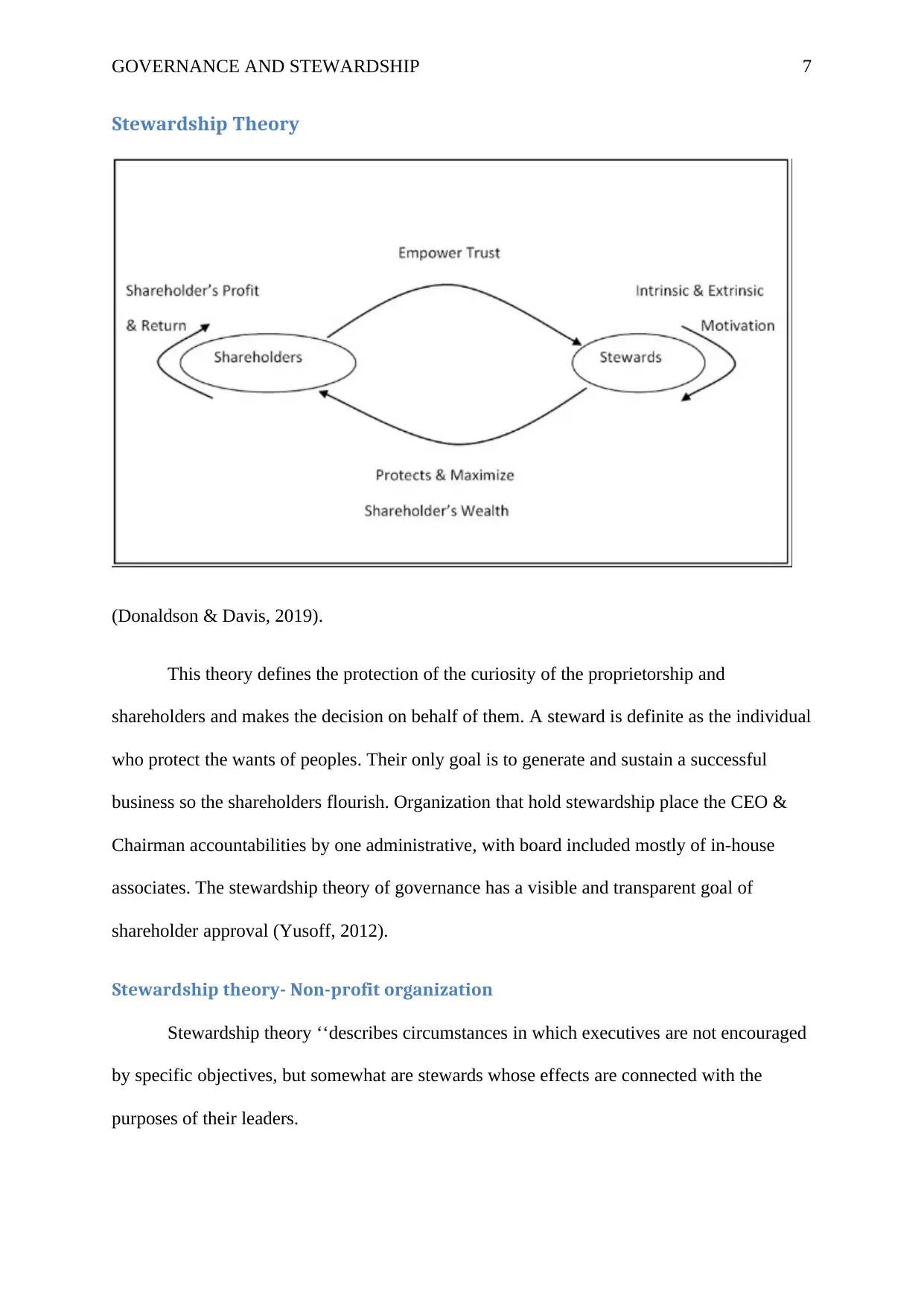
GOVERNANCE AND STEWARDSHIP 7
Stewardship Theory
(Donaldson & Davis, 2019).
This theory defines the protection of the curiosity of the proprietorship and
shareholders and makes the decision on behalf of them. A steward is definite as the individual
who protect the wants of peoples. Their only goal is to generate and sustain a successful
business so the shareholders flourish. Organization that hold stewardship place the CEO &
Chairman accountabilities by one administrative, with board included mostly of in-house
associates. The stewardship theory of governance has a visible and transparent goal of
shareholder approval (Yusoff, 2012).
Stewardship theory- Non-profit organization
Stewardship theory ‘‘describes circumstances in which executives are not encouraged
by specific objectives, but somewhat are stewards whose effects are connected with the
purposes of their leaders.
Stewardship Theory
(Donaldson & Davis, 2019).
This theory defines the protection of the curiosity of the proprietorship and
shareholders and makes the decision on behalf of them. A steward is definite as the individual
who protect the wants of peoples. Their only goal is to generate and sustain a successful
business so the shareholders flourish. Organization that hold stewardship place the CEO &
Chairman accountabilities by one administrative, with board included mostly of in-house
associates. The stewardship theory of governance has a visible and transparent goal of
shareholder approval (Yusoff, 2012).
Stewardship theory- Non-profit organization
Stewardship theory ‘‘describes circumstances in which executives are not encouraged
by specific objectives, but somewhat are stewards whose effects are connected with the
purposes of their leaders.
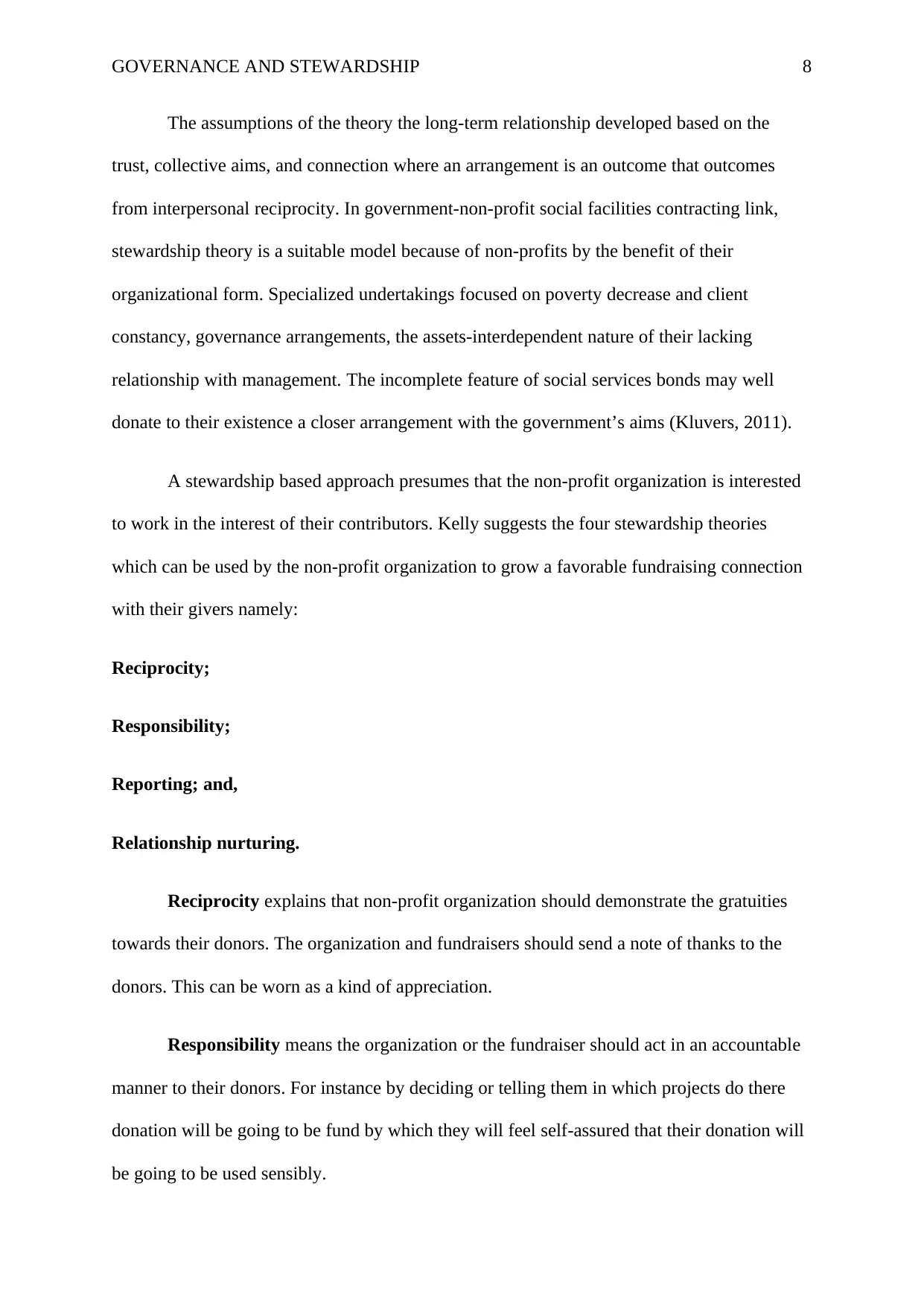
GOVERNANCE AND STEWARDSHIP 8
The assumptions of the theory the long-term relationship developed based on the
trust, collective aims, and connection where an arrangement is an outcome that outcomes
from interpersonal reciprocity. In government-non-profit social facilities contracting link,
stewardship theory is a suitable model because of non-profits by the benefit of their
organizational form. Specialized undertakings focused on poverty decrease and client
constancy, governance arrangements, the assets-interdependent nature of their lacking
relationship with management. The incomplete feature of social services bonds may well
donate to their existence a closer arrangement with the government’s aims (Kluvers, 2011).
A stewardship based approach presumes that the non-profit organization is interested
to work in the interest of their contributors. Kelly suggests the four stewardship theories
which can be used by the non-profit organization to grow a favorable fundraising connection
with their givers namely:
Reciprocity;
Responsibility;
Reporting; and,
Relationship nurturing.
Reciprocity explains that non-profit organization should demonstrate the gratuities
towards their donors. The organization and fundraisers should send a note of thanks to the
donors. This can be worn as a kind of appreciation.
Responsibility means the organization or the fundraiser should act in an accountable
manner to their donors. For instance by deciding or telling them in which projects do there
donation will be going to be fund by which they will feel self-assured that their donation will
be going to be used sensibly.
The assumptions of the theory the long-term relationship developed based on the
trust, collective aims, and connection where an arrangement is an outcome that outcomes
from interpersonal reciprocity. In government-non-profit social facilities contracting link,
stewardship theory is a suitable model because of non-profits by the benefit of their
organizational form. Specialized undertakings focused on poverty decrease and client
constancy, governance arrangements, the assets-interdependent nature of their lacking
relationship with management. The incomplete feature of social services bonds may well
donate to their existence a closer arrangement with the government’s aims (Kluvers, 2011).
A stewardship based approach presumes that the non-profit organization is interested
to work in the interest of their contributors. Kelly suggests the four stewardship theories
which can be used by the non-profit organization to grow a favorable fundraising connection
with their givers namely:
Reciprocity;
Responsibility;
Reporting; and,
Relationship nurturing.
Reciprocity explains that non-profit organization should demonstrate the gratuities
towards their donors. The organization and fundraisers should send a note of thanks to the
donors. This can be worn as a kind of appreciation.
Responsibility means the organization or the fundraiser should act in an accountable
manner to their donors. For instance by deciding or telling them in which projects do there
donation will be going to be fund by which they will feel self-assured that their donation will
be going to be used sensibly.
⊘ This is a preview!⊘
Do you want full access?
Subscribe today to unlock all pages.

Trusted by 1+ million students worldwide
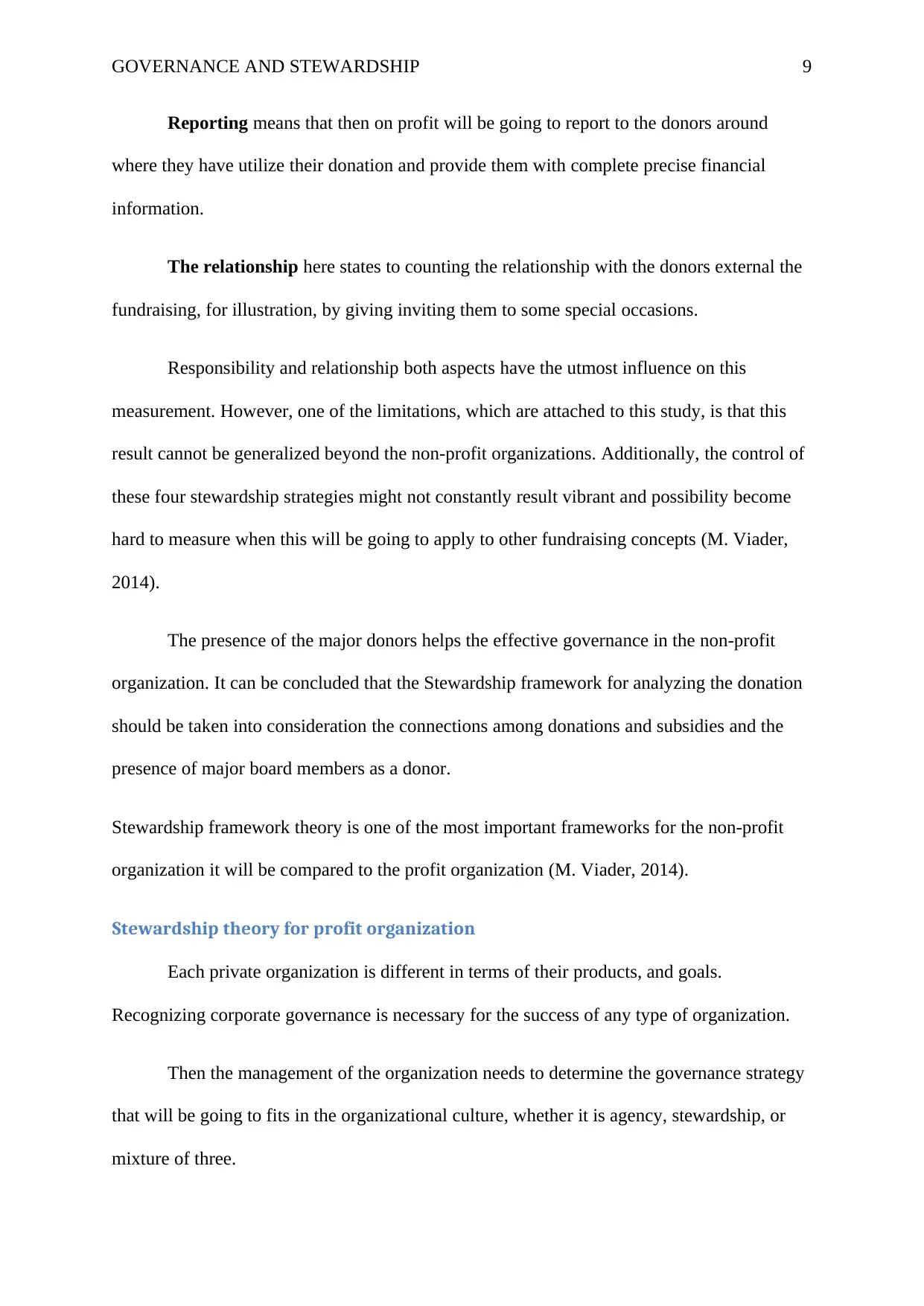
GOVERNANCE AND STEWARDSHIP 9
Reporting means that then on profit will be going to report to the donors around
where they have utilize their donation and provide them with complete precise financial
information.
The relationship here states to counting the relationship with the donors external the
fundraising, for illustration, by giving inviting them to some special occasions.
Responsibility and relationship both aspects have the utmost influence on this
measurement. However, one of the limitations, which are attached to this study, is that this
result cannot be generalized beyond the non-profit organizations. Additionally, the control of
these four stewardship strategies might not constantly result vibrant and possibility become
hard to measure when this will be going to apply to other fundraising concepts (M. Viader,
2014).
The presence of the major donors helps the effective governance in the non-profit
organization. It can be concluded that the Stewardship framework for analyzing the donation
should be taken into consideration the connections among donations and subsidies and the
presence of major board members as a donor.
Stewardship framework theory is one of the most important frameworks for the non-profit
organization it will be compared to the profit organization (M. Viader, 2014).
Stewardship theory for profit organization
Each private organization is different in terms of their products, and goals.
Recognizing corporate governance is necessary for the success of any type of organization.
Then the management of the organization needs to determine the governance strategy
that will be going to fits in the organizational culture, whether it is agency, stewardship, or
mixture of three.
Reporting means that then on profit will be going to report to the donors around
where they have utilize their donation and provide them with complete precise financial
information.
The relationship here states to counting the relationship with the donors external the
fundraising, for illustration, by giving inviting them to some special occasions.
Responsibility and relationship both aspects have the utmost influence on this
measurement. However, one of the limitations, which are attached to this study, is that this
result cannot be generalized beyond the non-profit organizations. Additionally, the control of
these four stewardship strategies might not constantly result vibrant and possibility become
hard to measure when this will be going to apply to other fundraising concepts (M. Viader,
2014).
The presence of the major donors helps the effective governance in the non-profit
organization. It can be concluded that the Stewardship framework for analyzing the donation
should be taken into consideration the connections among donations and subsidies and the
presence of major board members as a donor.
Stewardship framework theory is one of the most important frameworks for the non-profit
organization it will be compared to the profit organization (M. Viader, 2014).
Stewardship theory for profit organization
Each private organization is different in terms of their products, and goals.
Recognizing corporate governance is necessary for the success of any type of organization.
Then the management of the organization needs to determine the governance strategy
that will be going to fits in the organizational culture, whether it is agency, stewardship, or
mixture of three.
Paraphrase This Document
Need a fresh take? Get an instant paraphrase of this document with our AI Paraphraser
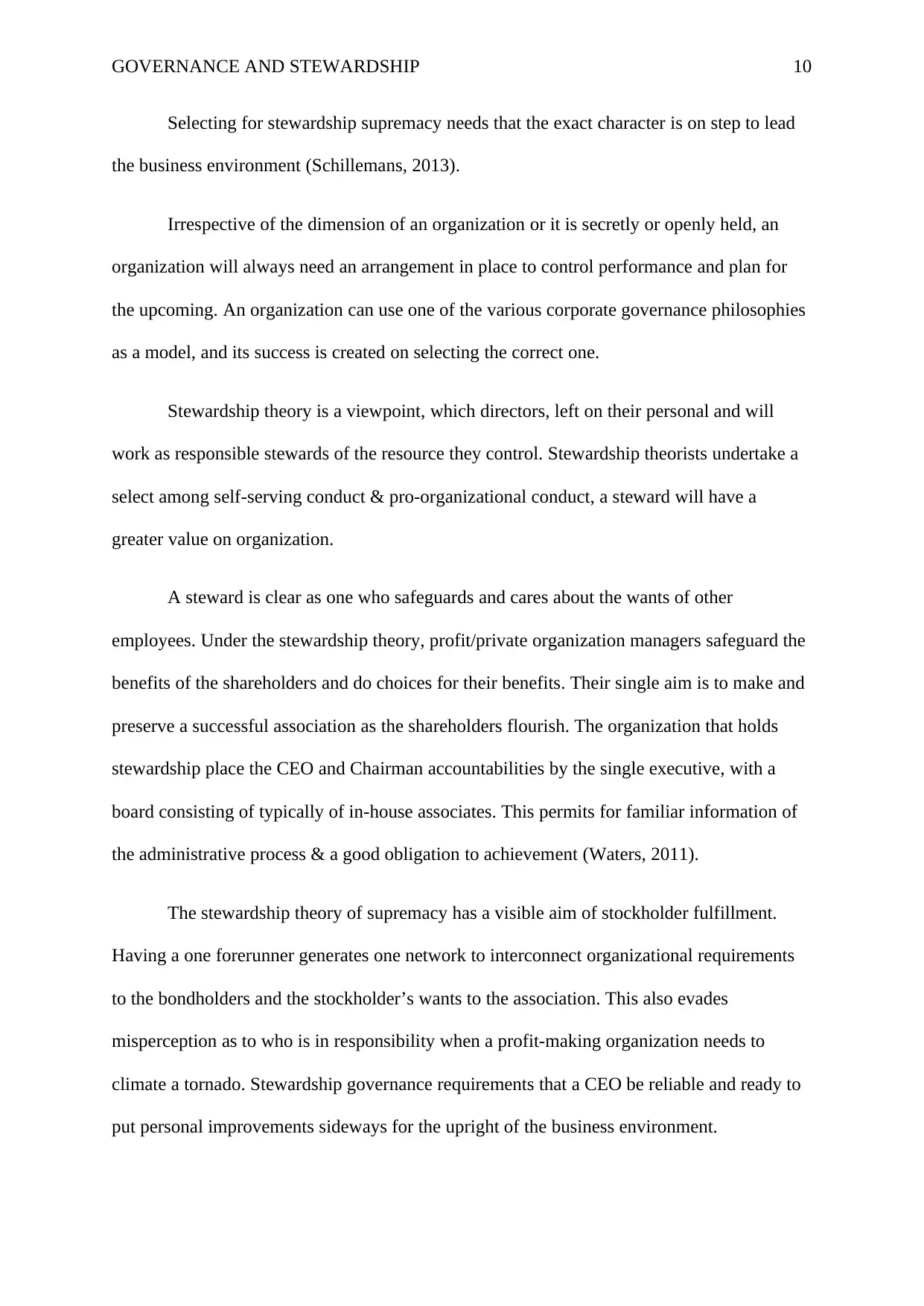
GOVERNANCE AND STEWARDSHIP 10
Selecting for stewardship supremacy needs that the exact character is on step to lead
the business environment (Schillemans, 2013).
Irrespective of the dimension of an organization or it is secretly or openly held, an
organization will always need an arrangement in place to control performance and plan for
the upcoming. An organization can use one of the various corporate governance philosophies
as a model, and its success is created on selecting the correct one.
Stewardship theory is a viewpoint, which directors, left on their personal and will
work as responsible stewards of the resource they control. Stewardship theorists undertake a
select among self-serving conduct & pro-organizational conduct, a steward will have a
greater value on organization.
A steward is clear as one who safeguards and cares about the wants of other
employees. Under the stewardship theory, profit/private organization managers safeguard the
benefits of the shareholders and do choices for their benefits. Their single aim is to make and
preserve a successful association as the shareholders flourish. The organization that holds
stewardship place the CEO and Chairman accountabilities by the single executive, with a
board consisting of typically of in-house associates. This permits for familiar information of
the administrative process & a good obligation to achievement (Waters, 2011).
The stewardship theory of supremacy has a visible aim of stockholder fulfillment.
Having a one forerunner generates one network to interconnect organizational requirements
to the bondholders and the stockholder’s wants to the association. This also evades
misperception as to who is in responsibility when a profit-making organization needs to
climate a tornado. Stewardship governance requirements that a CEO be reliable and ready to
put personal improvements sideways for the upright of the business environment.
Selecting for stewardship supremacy needs that the exact character is on step to lead
the business environment (Schillemans, 2013).
Irrespective of the dimension of an organization or it is secretly or openly held, an
organization will always need an arrangement in place to control performance and plan for
the upcoming. An organization can use one of the various corporate governance philosophies
as a model, and its success is created on selecting the correct one.
Stewardship theory is a viewpoint, which directors, left on their personal and will
work as responsible stewards of the resource they control. Stewardship theorists undertake a
select among self-serving conduct & pro-organizational conduct, a steward will have a
greater value on organization.
A steward is clear as one who safeguards and cares about the wants of other
employees. Under the stewardship theory, profit/private organization managers safeguard the
benefits of the shareholders and do choices for their benefits. Their single aim is to make and
preserve a successful association as the shareholders flourish. The organization that holds
stewardship place the CEO and Chairman accountabilities by the single executive, with a
board consisting of typically of in-house associates. This permits for familiar information of
the administrative process & a good obligation to achievement (Waters, 2011).
The stewardship theory of supremacy has a visible aim of stockholder fulfillment.
Having a one forerunner generates one network to interconnect organizational requirements
to the bondholders and the stockholder’s wants to the association. This also evades
misperception as to who is in responsibility when a profit-making organization needs to
climate a tornado. Stewardship governance requirements that a CEO be reliable and ready to
put personal improvements sideways for the upright of the business environment.
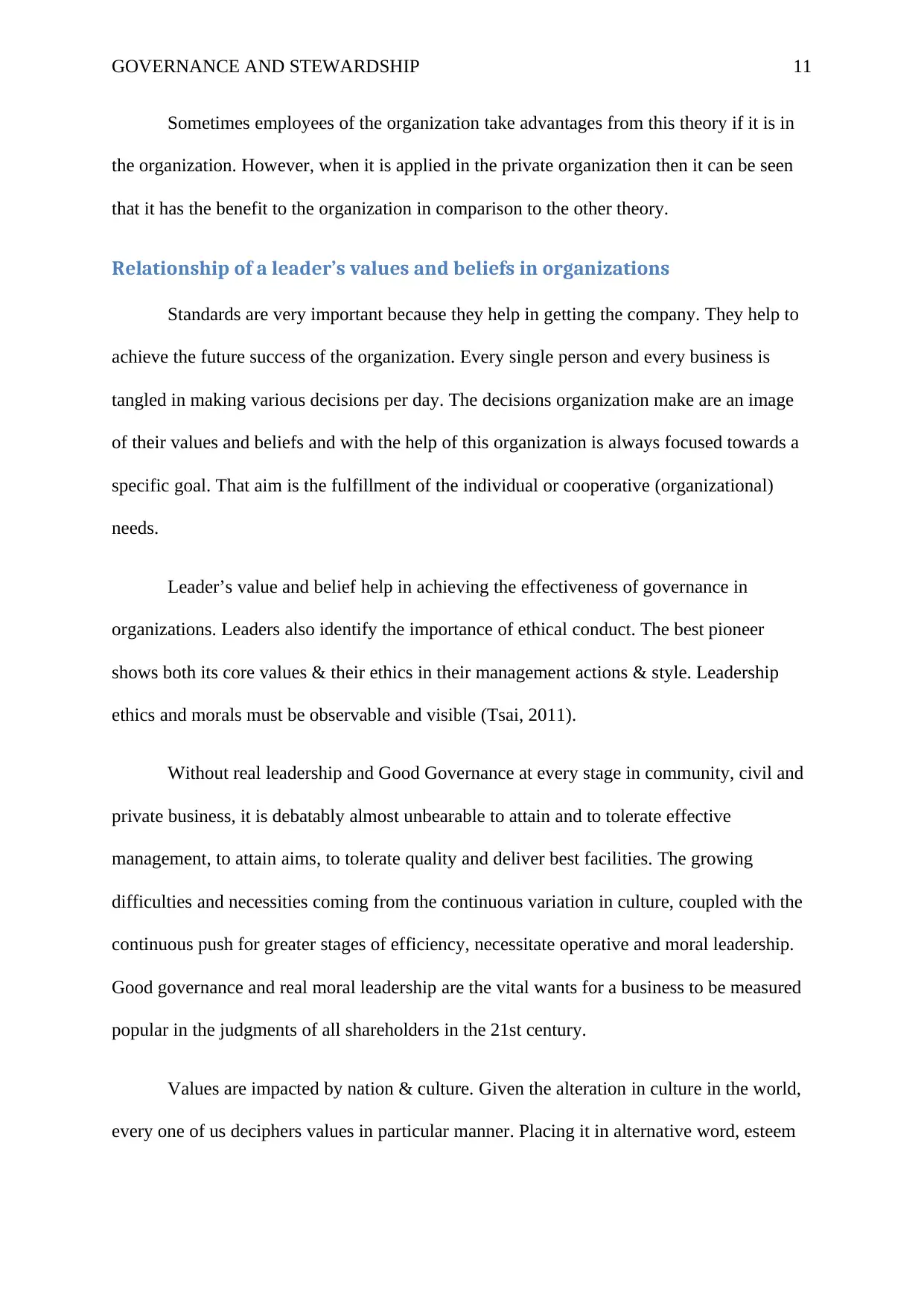
GOVERNANCE AND STEWARDSHIP 11
Sometimes employees of the organization take advantages from this theory if it is in
the organization. However, when it is applied in the private organization then it can be seen
that it has the benefit to the organization in comparison to the other theory.
Relationship of a leader’s values and beliefs in organizations
Standards are very important because they help in getting the company. They help to
achieve the future success of the organization. Every single person and every business is
tangled in making various decisions per day. The decisions organization make are an image
of their values and beliefs and with the help of this organization is always focused towards a
specific goal. That aim is the fulfillment of the individual or cooperative (organizational)
needs.
Leader’s value and belief help in achieving the effectiveness of governance in
organizations. Leaders also identify the importance of ethical conduct. The best pioneer
shows both its core values & their ethics in their management actions & style. Leadership
ethics and morals must be observable and visible (Tsai, 2011).
Without real leadership and Good Governance at every stage in community, civil and
private business, it is debatably almost unbearable to attain and to tolerate effective
management, to attain aims, to tolerate quality and deliver best facilities. The growing
difficulties and necessities coming from the continuous variation in culture, coupled with the
continuous push for greater stages of efficiency, necessitate operative and moral leadership.
Good governance and real moral leadership are the vital wants for a business to be measured
popular in the judgments of all shareholders in the 21st century.
Values are impacted by nation & culture. Given the alteration in culture in the world,
every one of us deciphers values in particular manner. Placing it in alternative word, esteem
Sometimes employees of the organization take advantages from this theory if it is in
the organization. However, when it is applied in the private organization then it can be seen
that it has the benefit to the organization in comparison to the other theory.
Relationship of a leader’s values and beliefs in organizations
Standards are very important because they help in getting the company. They help to
achieve the future success of the organization. Every single person and every business is
tangled in making various decisions per day. The decisions organization make are an image
of their values and beliefs and with the help of this organization is always focused towards a
specific goal. That aim is the fulfillment of the individual or cooperative (organizational)
needs.
Leader’s value and belief help in achieving the effectiveness of governance in
organizations. Leaders also identify the importance of ethical conduct. The best pioneer
shows both its core values & their ethics in their management actions & style. Leadership
ethics and morals must be observable and visible (Tsai, 2011).
Without real leadership and Good Governance at every stage in community, civil and
private business, it is debatably almost unbearable to attain and to tolerate effective
management, to attain aims, to tolerate quality and deliver best facilities. The growing
difficulties and necessities coming from the continuous variation in culture, coupled with the
continuous push for greater stages of efficiency, necessitate operative and moral leadership.
Good governance and real moral leadership are the vital wants for a business to be measured
popular in the judgments of all shareholders in the 21st century.
Values are impacted by nation & culture. Given the alteration in culture in the world,
every one of us deciphers values in particular manner. Placing it in alternative word, esteem
⊘ This is a preview!⊘
Do you want full access?
Subscribe today to unlock all pages.

Trusted by 1+ million students worldwide
1 out of 17
Related Documents
Your All-in-One AI-Powered Toolkit for Academic Success.
+13062052269
info@desklib.com
Available 24*7 on WhatsApp / Email
![[object Object]](/_next/static/media/star-bottom.7253800d.svg)
Unlock your academic potential
Copyright © 2020–2025 A2Z Services. All Rights Reserved. Developed and managed by ZUCOL.





